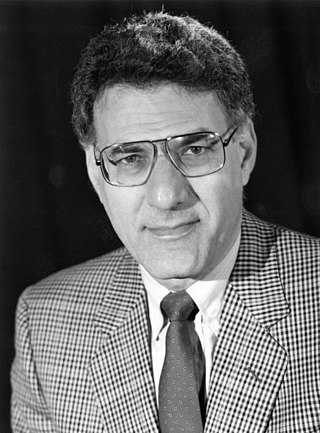Donald James Cram was an American chemist who shared the 1987 Nobel Prize in Chemistry with Jean-Marie Lehn and Charles J. Pedersen "for their development and use of molecules with structure-specific interactions of high selectivity." They were the founders of the field of host–guest chemistry.
David A. Evans was an American chemist who was the Abbott and James Lawrence professor of chemistry at Harvard University. He was a prominent figure in the field of organic chemistry and his research focused on synthetic chemistry and total synthesis, particularly of large biologically active molecules. Among his best-known work is the development of aldol reaction methodology.

Alfred Robert Bader, CBE was a Canadian chemist, businessman, philanthropist, and collector of fine art. He was considered by the Chemical & Engineering News poll of 1998 to be one of the "Top 75 Distinguished Contributors to the Chemical Enterprise" during C&EN's 75-year history.

Stephen Hanessian, OC, FRSC, is a chemist and professor of Canadian and United States citizenship born in Alexandria, Egypt. His research group at Université de Montréal is well known for developing synthetic methodologies, as well as natural product total synthesis. In addition, his group developed Chiron, a computer program used by organic chemists for synthetic planning.
Steven Victor Ley is Professor of Organic Chemistry in the Department of Chemistry at the University of Cambridge, and is a Fellow of Trinity College, Cambridge. He was President of the Royal Society of Chemistry (2000–2002) and was made a CBE in January 2002, in the process. In 2011, he was included by The Times in the list of the "100 most important people in British science".

Peter B. Dervan is the Bren Professor of Chemistry at the California Institute of Technology. The primary focus of his research is the development and study of small organic molecules that can sequence-specifically recognize DNA, a field in which he is an internationally recognized authority. The most important of these small molecules are pyrrole–imidazole polyamides. Dervan is credited with influencing "the course of research in organic chemistry through his studies at the interface of chemistry and biology" as a result of his work on "the chemical principles involved in sequence-specific recognition of double helical DNA". He is the recipient of many awards, including the National Medal of Science (2006).
Samuel J. Danishefsky is an American chemist working as a professor at both Columbia University and the Memorial Sloan-Kettering Cancer Center in New York City.

Julius Oscar Stieglitz was an American chemist of German Jewish origin. He was a teacher and organic chemist with a major interest in pharmaceutical and medicinal chemistry. He is known for the Stieglitz rearrangement, a rearrangement reaction in organic chemistry which commonly involves the formation of imines from hydroxylamines through a carbon to nitrogen shift, comparable to the key step of a Beckmann rearrangement.
James P. Collman is an American chemist who is the George A. and Hilda M. Daubert Professor of Chemistry, Emeritus at Stanford University. Collman's research focused on organometallic bioinorganic chemistry. Collman is a member of the National Academy of Sciences.
Samuel Marion McElvain was an American organic and synthetic chemist who spent his research career on the faculty of the University of Wisconsin.

Richard Frederick Heck was an American chemist noted for the discovery and development of the Heck reaction, which uses palladium to catalyze organic chemical reactions that couple aryl halides with alkenes. The analgesic naproxen is an example of a compound that is prepared industrially using the Heck reaction.

Osman Achmatowicz was a Polish professor of chemistry of Lipka Tatar descent. His son, Osman Achmatowicz Jr., is credited with the Achmatowicz reaction in 1971.
Akira Hosomi was a Japanese chemist. He was professor emeritus at Tsukuba University, a fellow of the Chemical Society of Japan, a visiting professor at Chuo University, and an academic advisor at Kyushu University.

The Department of Chemistry at the University of Manchester is one of the largest Departments of Chemistry in the United Kingdom, with over 600 undergraduate and more than 200 postgraduate research students.
Véronique Gouverneur is the Waynflete Professor of Chemistry at Magdalen College at the University of Oxford in the United Kingdom. Prior to the Waynflete professorship, she held a tutorial fellowship at Merton College, Oxford. Her research on fluorine chemistry has received many professional and scholarly awards.

Harkishan Singh was Professor Emeritus at the Panjab University. He was a well recognized pharmaceutical academic, medicinal chemistry researcher and science historian. He had more than half a century experience in his respective fields to his credit. He worked at the Banaras Hindu University, University of Saugar, and the Panjab University in India, and abroad at the University of Maryland, University of Mississippi and the University of London.
Douglas Wade Stephan is professor of Chemistry at the University of Toronto, a post he has held since 2008.
Cathleen M. Crudden is a Canadian chemist. She is a Canada Research Chair in Metal Organic Chemistry at Queen's University at Kingston. In February 2021, she took up the role of Editor-in-chief at ACS Catalysis.
Alexandros Makriyannis is an American biochemist and professor of Chemistry and Chemical Biology in the Department of Medicinal Chemistry at Northeastern University in Boston, Massachusetts, where he directs the Center for Drug Discovery and holds the George Behrakis Chair of Pharmaceutical Biotechnology. His research has focused on the biochemical basis of the endocannabinoid system and on the development of synthetic cannabinoids.
In organic chemistry, a directing group (DG) is a substituent on a molecule or ion that facilitates reactions by interacting with a reagent. The term is usually applied to C-H activation of hydrocarbons, where it is defined as a "coordinating moiety, which directs a metal catalyst into the proximity of a certain C–H bond." In a well known example, the ketone group in acetophenone is the DG in the Murai reaction.








